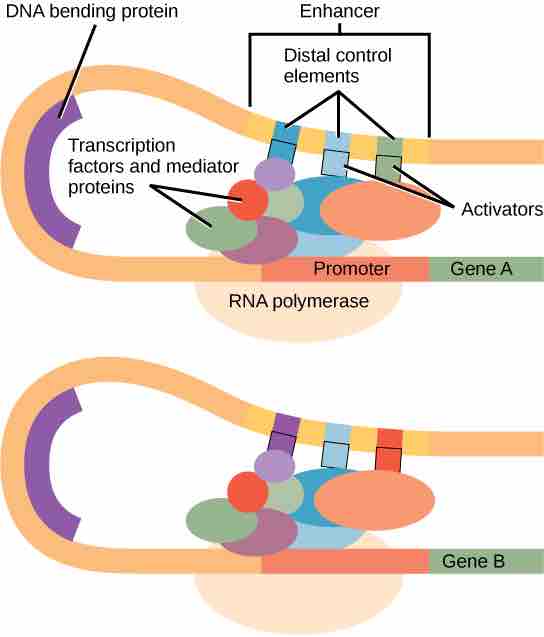Enhancers and Transcription
In some eukaryotic genes, there are regions that help increase or enhance transcription. These regions, called enhancers, are not necessarily close to the genes they enhance. They can be located upstream of a gene, within the coding region of the gene, downstream of a gene, or may be thousands of nucleotides away.
Enhancer regions are binding sequences, or sites, for transcription factors. When a DNA-bending protein binds to an enhancer, the shape of the DNA changes. This shape change allows the interaction between the activators bound to the enhancers and the transcription factors bound to the promoter region and the RNA polymerase to occur. Whereas DNA is generally depicted as a straight line in two dimensions, it is actually a three-dimensional object. Therefore, a nucleotide sequence thousands of nucleotides away can fold over and interact with a specific promoter .

Enhancers
An enhancer is a DNA sequence that promotes transcription. Each enhancer is made up of short DNA sequences called distal control elements. Activators bound to the distal control elements interact with mediator proteins and transcription factors.
Turning Genes Off: Transcriptional Repressors
Like prokaryotic cells, eukaryotic cells also have mechanisms to prevent transcription. Transcriptional repressors can bind to promoter or enhancer regions and block transcription. Like the transcriptional activators, repressors respond to external stimuli to prevent the binding of activating transcription factors.
A corepressor is a protein that decreases gene expression by binding to a transcription factor that contains a DNA-binding domain. The corepressor is unable to bind DNA by itself. The corepressor can repress transcriptional initiation by recruiting histone deacetylase, which catalyzes the removal of acetyl groups from lysine residues. This increases the positive charge on histones, which strengthens the interaction between the histones and DNA, making the DNA less accessible to the process of transcription.